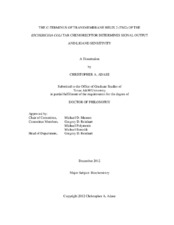| dc.description.abstract | Methyl-accepting chemotaxis proteins MCPs can bind one or more receptor- specific ligands. In the case of the Tar MCP of Escherichia coli (TarEc), a primary attractant ligand is aspartate. Its binding to the periplasmic domain of Tar generates a conformational change that is transmitted via helix 4 transmembrane helix 2 (TM2). An inward movement of TM2 initiates a transmembrane signal to the cytoplasmic HAMP (histidine kinases, adenyl cyclases, methyl-accepting proteins, phosphatases) domain. Baseline CheA kinase-stimulating activity and ligand-induced responses are both strongly influenced by residues at the C-terminus of transmembrane helix 2 (TM2). The cytoplasmic aromatic anchor, composed of residues Trp-209 and Tyr-210 in TarEc, is of particular importance. These residues are not highly conserved among transmembrane receptors having a HAMP domain, although there are almost always some aromatic residues in this region. The question thus becomes what properties of this aromatic anchor are necessary for proper signal transduction.
In this dissertation, I studied the effect on TarEc function by substituting all possible combinations of Ala, Phe, Tyr, and Trp at positions 209 and 210. This library of TarEc variants allowed the direct assessment of the effect of the residue composition of the aromatic anchor and led to a model of how the wild-type anchor maintains the base-line signaling state in TarEc. Additional receptor variants containing double aromatic tandems and Ala substitutions for the periplasmic Trp residue were created, and the aromatic residues were also shifted in position within the six residues 207-212.
Trp, Tyr, and Phe, in that order, had the greatest effect on function when they were moved to novel positions. It was also discovered that Gly-211 plays a critical role in maintaining receptor function. A model was generated that proposes that Gly-211 plays a role in maintaining the flexibility of the TM2-HAMP domain connector. The results suggest that the signaling properties of the transmembrane sensor kinases of two-component systems can be predicted by the nature of their TM2-HAMP connections. It may also be possible to modulate their activity in a controlled way by manipulating the amino acid sequences that comprise those connections. | en |


